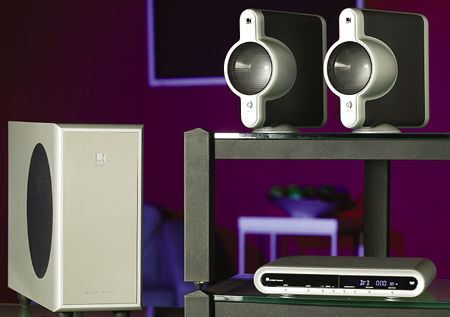KEF KIT100 Instant Theatre
There's more than one way to skin a cat—as mine will quickly discover if he claws my armchair again—and surround sound needs skinning. I've lost count of the number of potential home theater buffs who have asked for my advice and then balked at the idea of running cables for surround speakers. Mount a flat panel to the wall or a projector to the ceiling? No problem. Run speaker cables to the back of the room? The thought makes them flinch—I can see it in their eyes even before they start equivocating—and the dark forces of stereo claim another soul.

Something must be done to make home theater's audio side as attractive as its video side. That means making surround sound less invasive. It's a problem looking for a solution. Meanwhile, some folks in England would very much like to see their flat-panel speaker technology find new apps. There you have a solution looking for a problem. Problem, meet Solution; Solution, meet Problem.
Up to now, most solutions for the great unsolved surround problem have leaned on psycho-acoustic processing as a way of simulating surround effects from two speakers. However, KEF's engineers have come up with a different solution: What if the surround speakers could be built directly into the front-speaker enclosures? That's what KEF, a distinguished British speaker maker, and NXT, licensors of flat-panel speaker technology, have joined forces to create in the KIT100 Instant Theatre.
Real Surround Channels
The Instant Theatre uses real surround channels—no fakery. The system gets four channels out of two speakers by feeding the left and right surround channels into flat-panel drivers on the sides of the two main speakers. On the front of each speaker is a cone woofer and coaxial dome tweeter. This arrangement does not include a center speaker—the system relies on the phantom center effect, so it adds up to 4.1 channels. There's also a DVD/receiver that mimics both the physical form of the speakers and the mirrored front of the sub/amp module. Other HTIBs are homely by comparison.
The front (well, the only) speakers are weighty die-cast aluminum beauties that appear slim when viewed head on, and that is how you'll see them, since they're designed to be toed-in toward the listening position. On the front is a coaxial driver arrangement—what KEF calls a Uni-Q array—with a 0.5-inch tweeter mounted in the center of a 4-inch woofer. This arrangement effectively functions as a point source to achieve a perfect blend of the drivers' output. With no center speaker, that point-source precision is a crucial design feature.

On the speaker's side is an NXT driver that measures 8 by 5 inches, with a small cutout that fits it around the front woofer. Mounted on each flat-panel driver is a 1-inch exciter that makes the diaphragm vibrate. The flat panels don't just fake the surround effects. They reproduce them directly from Dolby Digital 5.1, DTS, or Dolby Pro Logic II channels, just as conventional sidewall-mounted surrounds would do. Well, OK, not directly—actually, the panels throw sound at the sidewalls, off which it bounces to reach the listening position.
At the heart of the system is the subwoofer. It's exactly the size and shape of a desktop PC. In the wiring scheme, it mediates between the DVD/receiver and the NXT-impregnated satellites, and it contains amplification for all of the channels. The Instant Theatre earns its I-word with a grand total of four connections. A DBA-25 cable connects the DVD/receiver to the sub. Two more DBA-25s connect the sub to the satellites. Connect your display, plug in the power, and you're done. After I'd uncrated the system, it took about a minute to plug everything in, and I was in no hurry.
Setup is easy because there isn't much to do. Separate test tones cover each channel (including the surrounds) and the sub. The sub crossover is fixed within the system. Speaker distance and surround delay are not adjustable. In the video menu are three aspect-ratio settings: widescreen 16:9, big-screen 4:3 (for letterboxed images on larger non-widescreen displays), and standard 4:3 (for pan-and-scan material on smaller non-widescreen displays). Progressive scanning is available via a switch.
The DVD/receiver can play various kinds of DVDs and CDs but not the high-resolution soundtracks on DVD-Audio discs and SACDs. There are no 5.1-channel analog audio inputs for a separate universal player, but there are enough inputs for a modest system with two more audio/video signal sources and a third audio-only source. Component video is the highest quality video output. If HDTV is part of your system, you'll have to route signals outside of the Instant Theatre. It does have an AM/FM tuner—allowing Howard Stern, Rush Limbaugh, and Al Franken to speak out of the Uni-Qs—which seems a mixed blessing at best.
Reflected Surround
In my room—both a song by Brian Wilson and, in this case, an important qualification—the Instant Theatre produced somewhat diffuse surround effects. The rear soundfield was a little nebulous, even compared with, say, bipolar designs that place the listener in a null field. One reason had to be the sidewall bounce. Another would be the frequency-response variation between the front and surround drivers.
In a bare-walled room, you shouldn't have to go to heroic lengths to get the best out of the Instant Theatre. My space, however, has a fair amount of urban-rathole clutter along the sidewalls. That has a diffusive effect, which is an asset with most speakers but not with these. So I tried an experiment: I placed reflective elements (actually, the sides of other speakers) alongside the KEFs to mimic the effect of closer, more-straightforwardly reflective sidewalls. The surround levels shot up several decibels on each side—as measured by the system's internal test tones and my SPL meter—but increasing the quantity of surround info didn't change the distinctive quality of the Instant Theatre's surround effects.























































